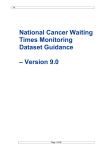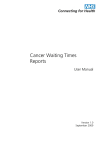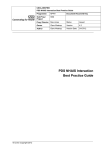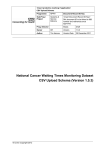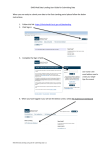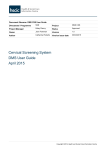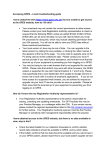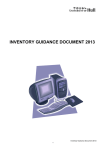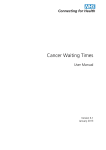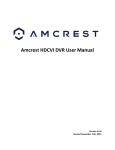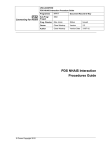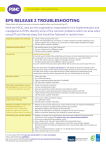Download CWT Data Upload and Reporting FAQ Document
Transcript
Cancer Waiting Times Database - Frequently Asked Questions Programme Sub-Prog / Project Systems & Service Delivery Prog. Director Owner Author Joan Foreman Status Issued Version 1.11 Version Date 5 November 2014 Cancer Waiting Times Database Frequently Asked Questions © HSCIC 2014 CWT - FAQs 05/11/2014/ Issued / 1.11 Amendment History: Version Date Amendment History 1.0 30/04/2009 Document Issued. 1.2 01/05/2009 ICD-10 and date information clarified. 1.3 12/05/2009 Further information. 1.4 13/05/2009 Further upload guidance regarding the PPI. 1.5 27/05/2009 Information on Reporting. 1.6 03/06/2009 More information on Reporting. 1.7 21/09/2009 Addition of further information. 1.8 20/10/2009 Inclusion of some additional reporting information 1.9 24/06/2010 Addition of information on reporting categories 1.10 01/11/2011 Correct DUC form link 1.11 05/11/2014 Updated links Reviewers: This document must be reviewed by the following: Name Signature Title / Responsibility Date Version Date Version Approvals: This document must be approved by the following: Name Signature Title / Responsibility Distribution: Document Status: This is a controlled document. Whilst this document may be printed, the electronic version maintained in FileCM is the controlled copy. Any printed copies of the document are not controlled. © HSCIC 2014 Page 2 of 16 CWT - FAQs 05/11/2014/ Issued / 1.11 Contents 1 ACCESSING THE CANCER WAITING TIMES DATABASE 1.1 1.2 2 5 DO I NEED ACCESS TO OPEN EXETER IN ORDER TO USE THE NATIONAL CANCER WAITING TIMES DATABASE? HOW DO I GAIN ACCESS TO OPEN EXETER? 5 5 UPLOADS 5 2.1 2.2 WHEN I TRY TO UPLOAD MY CSV FILE, I GET A LOT OF ERROR MESSAGES. WHERE CAN I GET HELP? MY CSV UPLOAD FILE PASSED THE INITIAL VALIDATION CHECKS, SO WHY WERE SOME OF THE RECORDS REJECTED WHEN THE UPLOAD WAS SUBSEQUENTLY PROCESSED? 2.3 WHAT ARE THE CROSS-FIELD VALIDATION CHECKS THAT ARE CARRIED OUT WHEN A RECORD IS TO BE ADDED TO THE DATABASE? 2.4 HOW DOES A RECORD IN A CSV UPLOAD UPDATE AN EXISTING RECORD ON THE CANCER WAITING TIMES DATABASE? 2.5 WHAT HAPPENS IF I UPLOAD THE SAME RECORD TWICE? 2.6 WHAT FIELDS DO I NEED TO COMPLETE IN ORDER TO UPLOAD JUST THE TREATMENT DETAILS FOR AN EXISTING REFERRAL RECORD? 7 2.7 WHAT FIELDS DO I NEED TO COMPLETE IN ORDER TO UPLOAD SUBSEQUENT TREATMENTS? 3 DOWNLOADS 3.1 4 WHY DOES MY DOWNLOAD STILL SHOW AS 'READY TO DOWNLOAD'? 6 6 6 7 8 DATA ITEM FORMATS 8 8 8 8 9 9 9 9 9 10 RECORD ENTRY SCENARIOS 10 5.1 5.2 5.3 5.4 5.5 HOW SHOULD METASTATIC CONDITIONS BE ENTERED? HOW IS CHEMOTHERAPY TO BE ENTERED ONTO THE SYSTEM? HOW DO I ENTER A PATIENT PAUSE WHERE A PATIENT HAS DECLINED ALL TREATMENT? WHAT IS THE PROCESS WHEN A PATIENT IS FIRST SEEN AT A PRIVATE HOSPITAL? WHAT DATA DO I RECORD FOR A PATIENT WHO DIES BEFORE TREATMENT, OR WHO CHOOSES TO HAVE TREATMENT PRIVATELY OR ABROAD? 5.6 DO I NEED TO CREATE A RECORD FOR A PATIENT WHO IS DIAGNOSED AS NOT HAVING CANCER? 5.7 IS INFORMATION NEEDED ON MILITARY PERSONNEL? 5.8 IS IT POSSIBLE TO UPLOAD INFORMATION ON PATIENTS WITH SCOTTISH NHS NUMBERS? 6 5 8 4.1 HOW SHOULD PATIENT PATHWAY IDENTIFIERS (PPI’S) BE ENTERED? 4.1.1 Format of PPI’s 4.1.2 Choose and Book referrals 4.1.3 Incorrect use of PPI’s can result in duplicate records 4.2 WHAT IS THE FORMAT OF PRIMARY DIAGNOSIS (ICD) CODES? 4.3 WHY CAN’T I JUST SUPPLY A THREE CHARACTER PRIMARY DIAGNOSIS (ICD) CODE? 4.4 WHAT IS THE DATE FORMAT THAT MUST BE USED FOR UPLOADS? 4.5 WHAT IS THE DATE FORMAT THAT MUST BE USED FOR ENTERING DATA IN THE RECORD SCREEN? 4.6 HOW DO I KNOW WHICH PROVIDER ORGANISATION CODES TO USE? 5 5 REPORTING 10 10 10 11 11 11 12 12 12 6.1 6.2 6.3 WHY CAN'T I SEE MY DATA IN THE REPORTS? 12 I MISSED THE DEADLINE FOR THE MONTHLY REPORTS – SHOULD I STILL UPLOAD THE RECORDS FOR THIS MONTH? 12 WHY DON’T THE FIGURES IN THE MONTHLY REPORTS ADD UP TO THE FIGURES IN THE CORRESPONDING QUARTERLY REPORT? 12 6.4 WHERE ARE THE REPORTS THAT I USED TO HAVE IN THE OLD SYSTEM, THAT APPEAR TO BE NO LONGER AVAILABLE IN THE NEW SYSTEM? 13 6.5 WHERE ARE THE MONTHLY REPORTS FOR JANUARY AND FEBRUARY 2009? 13 © HSCIC 2014 Page 3 of 16 CWT - FAQs 05/11/2014/ Issued / 1.11 6.6 THE SUBSEQUENT TREATMENT REPORTS CONTAIN DATA FOR RADIOTHERAPY TREATMENTS, WHICH IS NOT A LIVE TARGET 13 6.7 WHAT IS THE DIFFERENCE BETWEEN REPORTS 1.1, 6.1, 12.1, 12.20, ETC.? 14 6.8 HOW ARE THE DIFFERENT ‘REPORTING CATEGORIES’ DETERMINED? 14 6.8.1 Tumour Type 14 6.8.2 Treatment Modality 15 6.8.3 Treatment Group 15 UNTIL 2010. WHY IS THIS BEING INCLUDED IN THE REPORT NOW? 7 THE LEGACY SYSTEM 7.1 7.2 8 16 HOW DO I ACCESS MY DATA THAT RELATES TO THE OLD SYSTEM? IS IT POSSIBLE TO MODIFY DATA IN THE LEGACY SYSTEM? 16 16 THE HELP DESK 8.1 16 HOW DO I OBTAIN FURTHER ASSISTANCE? © HSCIC 2014 16 Page 4 of 16 CWT - FAQs 05/11/2014/ Issued / 1.11 1 Accessing the Cancer Waiting Times Database 1.1 Do I need access to Open Exeter in order to use the National Cancer Waiting Times Database? Yes. The National Cancer Waiting Times application can only be accessed via the secure Internet connection provided by Open Exeter. 1.2 How do I gain access to Open Exeter? In order to gain access to Open Exeter, you will need to complete a Data User Certificate. Once you have been authorised to access Open Exeter you will be given the website address, a user ID and a password. A Data User Certificate can be found here: http://systems.hscic.gov.uk/ssd/prodserv/cwtduc.pdf 2 Uploads 2.1 When I try to upload my CSV file, I get a lot of error messages. Where can I get help? The National Cancer Waiting Times User Manual includes full details on how to create a CSV upload file, including the record layout you should use, the validation and processing rules that are carried out by the upload process, and tips for creating a CSV file using MS Excel or MS Access. The user manual can be found here: http://nww.hscic.gov.uk/nhais/cancerwaiting/cwtmanual61.pdf If you are still having problems after reading this document, please call the Help Desk on 01392 251289, and our support staff will be happy to advise you. 2.2 My CSV upload file passed the initial validation checks, so why were some of the records rejected when the upload was subsequently processed? When you try to upload your CSV upload file, a basic set of validation checks is carried out on the data being uploaded. If these checks are successful, the file is put into the upload queue, awaiting further processing. During the subsequent processing of the CSV file, additional checks are carried out. Firstly, a search is carried out on the Patient Demographics Service (PDS) for the patient's NHS Number. This can fail for a number of reasons, e.g. the NHS Number does not exist. © HSCIC 2014 Page 5 of 16 CWT - FAQs 05/11/2014/ Issued / 1.11 If the search is successful, the record is checked against the patient's date of birth, held on PDS, and the record may be rejected if, for example, the suspected cancer type is inappropriate according to whether the patient is a child or an adult. Finally, a record that is updating details already stored on the National Cancer Waiting Times database must be validated against the existing record, to ensure the values being uploaded do not conflict with those already on the database. The validation checks carried out when you post your file onto the upload queue, and those done during the subsequent processing of the file, are fully documented in CSV Upload Schema: http://nww.hscic.gov.uk/nhais/cancerwaiting/csvuploadschema.pdf 2.3 What are the cross-field validation checks that are carried out when a record is to be added to the database? The rules for cross-field validation can be found in the CSV Upload Specification: http://nww.hscic.gov.uk/nhais/cancerwaiting/csvuploadschema.pdf 2.4 How does a record in a CSV upload update an existing record on the Cancer Waiting Times database? During the upload process, the Cancer Waiting Times application attempts to match each incoming record within the CSV file to records that are already saved in the database, based on the flowchart in the Record Matching section of the CSV Upload specification: http://nww.hscic.gov.uk/nhais/cancerwaiting/csvuploadschema.pdf If a match with an existing record is found, the new record will be merged with the existing record and the existing record will be updated in the database. The merger will be carried out as follows: If a field on the upload record contains a value, the same field on the database record will be changed to this value. If a field on the upload record is blank, the same field on the database record is not changed i.e. it is not possible to update an existing field with a blank. This allows partial records to be entered further down the patient pathway, without having to resupply earlier data. If a matching record is not found, then a new record will be created on the database. 2.5 What happens if I upload the same record twice? If the same record is uploaded twice and the system is able to match the second instance record with the first, then the existing record will be updated – there will only be one entry on the database for that record (although the update to the record will show up in the audit history). But, if the same record is uploaded twice and the system is NOT able to match the second record with the first, then a new record will be created – a duplicate record. © HSCIC 2014 Page 6 of 16 CWT - FAQs 05/11/2014/ Issued / 1.11 For details of the attempted record matching that is carried out by the system, please see the flowchart in the Record Matching section of the CSV Upload Specification: http://nww.hscic.gov.uk/nhais/cancerwaiting/csvuploadschema.pdf 2.6 What fields do I need to complete in order to upload just the treatment details for an existing referral record? You must supply the: NHS NUMBER PATIENT PATHWAY IDENTIFIER PATIENT PATHWAY ISSUER CANCER REFERRAL TO TREATMENT PERIOD START DATE DATE FIRST SEEN CANCER TREATMENT PERIOD START DATE and TREATMENT START DATE This is to ensure that your upload record will match - and update - the existing record on the NCWT database containing the referral details. For full details of the matching process that is carried out, please see the flowchart in the Record Matching section of the CSV Upload Specification: http://nww.hscic.gov.uk/nhais/cancerwaiting/csvuploadschema.pdf The above fields are sufficient to create a record, but the record will not be included in the monthly and quarterly reports unless it fully conforms to DSCN 20/2008 by the deadline date. 2.7 What fields do I need to complete in order to upload subsequent treatments? You must supply the NHS NUMBER PATIENT PATHWAY IDENTIFIER PATIENT PATHWAY IDENTIFIER ISSUER CANCER TREATMENT PERIOD START DATE AND TREATMENT START DATE. The CANCER TREATMENT EVENT TYPE must also be supplied, and be set to something other than 01 or 07. All the other treatment details should be provided. However, leave the referral details blank – no referral details should be provided when uploading subsequent treatments. The above fields are sufficient to create a record, but the record will not be included in the monthly and quarterly reports unless it fully conforms to DSCN 20/2008 by the deadline date. © HSCIC 2014 Page 7 of 16 CWT - FAQs 05/11/2014/ Issued / 1.11 3 Downloads 3.1 Why does my download still show as 'Ready to download'? Once a download has been processed, its status is set to (and will remain as) 'Ready to download', because even if you have already downloaded the file, you can still download it again at a later date. 4 Data Item Formats 4.1 How should Patient Pathway Identifiers (PPI’s) be entered? The following sections describe how PPI’s are entered and used. 4.1.1 Format of PPI’s A PATIENT PATHWAY IDENTIFIER (PPI) is mandatory in a patient record, and must be recorded on the CWT-Db Exeter based system by the 25th working day following the end of a period. However, this means that the data item could be entered in a two week wait record, but not included in the subsequent treatment record that is matched to it. This is the same principal as the CWT-Db has always operated under, and is designed to give provider trusts flexibility in how they collect these data. The requirement not to include a PPI is not one of the written rules as the data item is still required at some point before the 25th working day. However, the Record Matching flowchart in the CSV Upload Schema does demonstrate how this identifier is used in the matching of records, in the case of it being present in both records, one record or neither record. When a PPI is uploaded it must contain 20 characters. It can contain any alphanumeric character. The system will accept “padding” in order ensure the record passes validation. However, we would not recommend using spaces as padding, and would suggest a sensible approach could be to use leading zeros or X’s. e.g. Assuming reference of ABC123456789 is used, the following could be entered for the PPI: 00000000ABC123456789 4.1.2 Choose and Book referrals The data standard for PPI's for Choose and Book referrals is: “X09UBRN=......” As “X09UBRN=” is 8 characters in length, there are 12 characters remaining to enter the Choose and Book reference. If this is less than 12 characters it will need to be padded to be 12 characters in length, so that the total length of the PPI is 20 characters. e.g. if your Choose and Book reference is 12345, you could use a PPI of: © HSCIC 2014 Page 8 of 16 CWT - FAQs 05/11/2014/ Issued / 1.11 X09UBRN=000000012345 For Choose and Book referrals, the PPI Issuer should be 'X09' 4.1.3 Incorrect use of PPI’s can result in duplicate records Important: If you re-upload the same record with a different PPI (e.g. replacing padding with XXX for padding with 000), because the PPI is different, this will create new (duplicate) records. 4.2 What is the format of PRIMARY DIAGNOSIS (ICD) Codes? PRIMARY DIAGNOSIS (ICD) codes must be entered using either three or five characters, depending on the code. Some codes are only three characters long (e.g. C61). This is not broken down to a lower level of classification (i.e. C61.0, C61.1, etc. do not exist) therefore this type of code should be entered using three characters only – no padding should be used for codes that are less than five characters. Other codes are broken down to a lower level of classification and therefore they are five characters in length, e.g. C18.0, C18.1, etc. These should be entered using all five characters. The exact code is required by the CWT-Db. The full list of allowable ICD-10 codes can be found here: http://nww.hscic.gov.uk/nhais/cancerwaiting/clincoding 4.3 Why can’t I just supply a three character Primary Diagnosis (ICD) Code? During consultation, most NHS providers asked for more detail to support planning. They also advised that it was actually easier to include the extra two digits, as their pathology labs send them the fully coded data and stripping out the extra characters would be timeconsuming. 4.4 What is the date format that must be used for uploads? The upload date format that must be used is YYYY-MM-DD. No future dates will be accepted by the system - the date entered must be on or before the date of the upload. 4.5 What is the date format that must be used for entering data in the Record Screen? The date format that must be used when keying in the data via the Record Screen is DD/MM/YYYY. No future dates will be accepted by the system - the date entered must be on or before the current date. © HSCIC 2014 Page 9 of 16 CWT - FAQs 4.6 05/11/2014/ Issued / 1.11 How do I know which provider organisation codes to use? All organisation codes entered into the National Cancer Waiting Times system must be a valid five character NHS trust site code (NB not your three character trust code, with a '00' suffix). The sites within your own trust should all have codes beginning with your three character trust code. Remember that the records included in your reports and downloads will be those where the patient was first seen or treated by one of your trust's sites. The full set of trust site codes can be queried and is available for download from the Organisation Data Service. Visit their website at: http://nww.hscic.gov.uk/ods 5 Record Entry Scenarios 5.1 How should metastatic conditions be entered? The Cancer Waiting Times Database expects a new record for every treatment. Therefore, if CANCER TREATMENT EVENT TYPE of “01 - First definitive treatment for a new primary cancer” is used, it is expected that the metastatic field will be blank, as the trust is reporting the treatment of the primary. Where a primary is known and a treatment is for a metastatic condition, it is expected that a separate 31-day treatment record will be supplied including the ICD-10 of the original primary and details of the metastatic site. Treatment of metastatis is only a first treatment (with both fields coded to the metastatis) when the primary is unknown and the CANCER TREATMENT EVENT TYPE is “07 - First treatment for metastatic disease following an unknown primary”. 5.2 How is chemotherapy to be entered onto the system? Chemotherapy is considered to be one treatment and therefore contains multiple cycles, only the first of which should be recorded, because TREATMENT START DATE (CANCER) relates to the date a course commences. 5.3 How do I enter a patient pause where a patient has declined all treatment? If a patient has declined all treatment at the point of offering and is not just declining one treatment option before agreeing a different package of care the patient has not actually initiated a pause, so one should not be recorded. However this does constitute a clock stop for both cancer waits and the 18-week RTT programme. Most data items within the record will be completed as normal. However, some data items are specific to the patient’s decision to decline treatment. These items should be completed as follows: CANCER TREATMENT PERIOD START DATE is the date the care plan that was subsequently declined was agreed with the patient; © HSCIC 2014 Page 10 of 16 CWT - FAQs 05/11/2014/ Issued / 1.11 TREATMENT START DATE CANCER is the date the patient declined the treatment package (unless the patient requested time to think about their options this will be the same date as the CANCER TREATMENT PERIOD START DATE; CANCER TREATMENT MODALITY should be recorded as code "98" as all treatment is declined; CANCER CARE SETTING (TREATMENT) should be recorded as "99" (unknown) because no treatment has been delivered it cannot be known; and CLINICAL TRIAL INDICATOR could be recorded as either "99" (unknown) or "02" as the patient is obviously not taking part in a clinical trial as all treatment has been declined. Whichever option used would depend on how your local system is set up, but both are valid options. 5.4 What is the process when a patient is first seen at a private hospital? The waiting targets apply to the NHS. If a patient is first seen privately, the 2 Week Wait target would not apply. However, if they are subsequently referred into the NHS and receive their first treatment in the NHS, then the 31-Day target will apply. The clock will start ticking at the CANCER TREATMENT PERIOD START DATE in the NHS. The mandate in DSCN 20/2008 specifies retrospective reporting after the activity has taken place. This means that if there is no DATE FIRST SEEN an outpatient record should not be recorded, and if there is no TREATMENT START DATE (CANCER) a treatment record should not be entered. 5.5 What data do I record for a patient who dies before treatment, or who chooses to have treatment privately or abroad? If the patient was a 2 week wait referral (i.e. CANCER REFERRAL PRIORITY TYPE is 03 – Two Week Wait) and was seen in outpatients, there will just be a record reporting the 14 day standard. If the patient was not a 2 week wait referral, or entered secondary care by another route, no record for this patient will be entered onto the system. The mandate in DSCN 20/2008 specifies retrospective reporting after the activity has taken place. This means that if there is no DATE FIRST SEEN an outpatient record should not be recorded, and if there is no TREATMENT START DATE (CANCER) a treatment record should not be entered. 5.6 Do I need to create a record for a patient who is diagnosed as not having cancer? Data on patients entering secondary care via the Two Week Wait or from an NHS Cancer Screening Service who are not subsequently diagnosed with cancer should have a partial record completed as specified on page 13 of DSCN 20/2008. © HSCIC 2014 Page 11 of 16 CWT - FAQs 5.7 05/11/2014/ Issued / 1.11 Is information needed on military personnel? The NHS Cancer Plan standards have been set for all patients cared for under the NHS in England. Therefore, if a member of the armed forces is treated in an NHS hospital then they are covered by these targets and data should be collected (provided an NHS Number is available for the patient). 5.8 Is it possible to upload information on patients with Scottish NHS numbers? No, it is not possible to upload information on patients with Scottish NHS numbers. 6 Reporting 6.1 Why can't I see my data in the reports? The most likely cause is because the reports have already been generated. Reports are generated on or just after the 25th working day (based on a 5-day working week, i.e. excluding weekends and bank holidays) after the end of a reporting period (a month or a quarter). It is important to note that once the reports have been generated, these are never changed; they can be thought of as a 'snapshot' of the database, taken at the time they are generated. You therefore need to ensure that all data to be included in reports are uploaded before the 25th working day. If you are uploading data from CSV files, give yourself a few days to check and correct any errors that may occur – we recommend you use the download facility to check that your data is complete and correct. Any new records created, or modifications made to existing records after this date, will not be reflected in the reports that have already been generated. 6.2 I missed the deadline for the monthly reports – should I still upload the records for this month? Yes. Don't forget that records missed from a monthly report may still be included in a quarterly report (unless the month you missed was the last in the quarter). 6.3 Why don’t the figures in the monthly reports add up to the figures in the corresponding quarterly report? It is possible that the figures in a quarterly report will not equal the sum of the figures in each of the corresponding monthly reports. This is because it is possible to change the data that was used to generate the monthly reports after the monthly reports have been generated and before the corresponding quarterly reports are generated. Once the reports have been generated, their figures are fixed and are not affected by further data changes. © HSCIC 2014 Page 12 of 16 CWT - FAQs 6.4 05/11/2014/ Issued / 1.11 Where are the reports that I used to have in the old system, that appear to be no longer available in the new system? An extensive range of new reports has been designed for use in the new system. Unfortunately, due to time constraints, NHS Connecting for Health (NHS CFH) have not yet been able to develop all of these new reports. It has been necessary to prioritise functionality and ensure that the new system is able to collect, audit and download data in the format specified in DSCN 20/2008 and ensure that that the key reports could be generated before the reporting deadlines. A number of the new reports have been given a lower priority and are currently still being developed. These remaining lower priority reports will become available in the new system in due course. The following document contains a list of all of the new reports, as well as detailing when they are expected to become available: National Cancer Waiting Times Reports Release Policy and Current Release Status: http://nww.hscic.gov.uk/nhais/cancerwaiting/releasestat.xls The following document details the reports that are currently available and how they can be used: National Cancer Waiting Times Reports User Manual: http://nww.hscic.gov.uk/nhais/cancerwaiting/cwtmanual61.pdf 6.5 Where are the monthly reports for January and February 2009? The monthly reports for January and February 2009 were not generated and therefore are not available. This is because NHS Connecting for Health (NHS CFH) were in the process of developing the new version of the Cancer Waiting Times Database when the report generation dates occurred for the January and February 2009 monthly reports (25 working days after the end of each month). Therefore, since the new system was not accessible and users had not been able to upload their January and February 2009 data, it was not possible for NHS CFH to take a snapshot of the database and generate the monthly reports for January and February 2009. Therefore, NHS CFH agreed with the Department of Health that the monthly reports for January and February 2009 were not to be generated, so these reports are not available. Monthly reports from March 2009 onwards will be available as normal. 6.6 The subsequent treatment reports contain data for radiotherapy treatments, which is not a live target until 2010. Why is this being included in the report now? The subsequent treatment reports include all modalities, not just the live standards, although only the live standards will be published by the Department of Health and used in the Care Quality Commission assessment programme. The reports include all treatment categories to © HSCIC 2014 Page 13 of 16 CWT - FAQs 05/11/2014/ Issued / 1.11 support the development of services to meet the 2010 standards and to enable performance management against Vital Signs trajectories and local Service Level Agreements within health economies. 6.7 What is the difference between reports 1.1, 6.1, 12.1, 12.20, etc.? The key difference is the ‘base’ of the report – 1.1 and 12.1 are Provider based; 6.1 and 12.20 are Commissioner based. Provider based reports count patients according to where the service was provided – where the patient was first seen (for 2 week wait reports) or where the patient was first treated (for 31 day and 62 day reports). Commissioner based reports count patients according to the patient’s residence – i.e. which PCT area they live in. So report 12.1 shows all the patients eligible for a two week wait standard who were first seen at a Trust which is the responsibility of the Cancer Network, regardless of whether or not the patient lives in the Cancer Network’s area. Report 12.20 shows all the patients eligible for a two week wait standard who live in the Cancer Network’s area, regardless of whether or not the patient was first seen at one of the Cancer Network’s Trusts. There is very little difference between reports 6.1 and 12.20. The ‘All Primary Care Trusts’ tab on report 6.1 gives exactly the same figures as appear on report 12.20. The only difference is that report 6.1 then goes on to break down the summary figures by PCT. 6.8 How are the different ‘reporting categories’ determined? Care records are categorised in 3 different ways for the reports: 6.8.1 Tumour Type For 2 week wait reports, this is the Urgent Cancer or Symptomatic Breast Referral Type entered on the Care Record. For 31 day and 62 day reports, it is based on the Primary Diagnosis Code entered on the Care Record which will fall into one of the following categories: • Breast • Lung • Haematological (Excluding Acute Leukaemia) • Upper Gastrointestinal • Lower Gastrointestinal • Skin • Gynaecological • Brain/Central Nervous System © HSCIC 2014 Page 14 of 16 CWT - FAQs 05/11/2014/ Issued / 1.11 • Urological (Excluding Testicular) • Head and Neck • Sarcoma • Other • Acute leukaemia • Testicular 6.8.2 Treatment Modality This is the Cancer Treatment Modality entered on the Care Record 6.8.3 Treatment Group This is based on the Cancer Treatment Modality entered on the Care Record, categorised as follows: Treatment Group CANCER TREATMENT MODALITY code CANCER description Surgery 01 Surgery Drug Treatments 02 Anti-Cancer Drug Chemotherapy) Regimen (Cytotoxic Drug Treatments 03 Anti-Cancer Therapy) Regimen (Hormone Radiotherapy Treatments 04 Chemoradiotherapy Radiotherapy Treatments 05 Teletherapy (Beam radiation excluding Proton Therapy) Radiotherapy Treatments 06 Brachytherapy Palliative Treatments 07 Specialist Palliative Care Palliative Treatments 08 Active Monitoring (excluding Specialist Palliative Care) Palliative Treatments 09 Non-Specialist Palliative Care (excluding Active Monitoring) Other Treatments 10 Radio Frequency Ablation (RFA) Other Treatments 11 High Intensity Focussed Ultrasound (HIFU) Other Treatments 12 Cryotherapy Radiotherapy Treatments 13 Proton Therapy © HSCIC 2014 TREATMENT Drug MODALITY Non- Page 15 of 16 CWT - FAQs 05/11/2014/ Issued / 1.11 Treatment Group CANCER TREATMENT MODALITY code CANCER description TREATMENT Drug Treatments 14 Anti-Cancer Drug Regimen (Other) Drug Treatments 15 Anti-Cancer (Immunotherapy) Other Treatments 16 Light Therapy (including Photodynamic Therapy and PUVA) Other Treatments 17 Hyperbaric Oxygen Therapy Other Treatments 99 Other All Treatments Declined 98 All Treatment Declined (English NHS) Drug MODALITY Regimen NB: The “All Treatments” category is to include all code possibilities except code ‘98’ 7 The Legacy System 7.1 How do I access my data that relates to the old system? Data for 31st December 2008 and before can be accessed via the Legacy system. To access this system, click on the Legacy link on the main navigation bar. 7.2 Is it possible to modify data in the Legacy system? No, it is not possible to modify data in the Legacy system. The Legacy system is read-only. 8 The Help Desk 8.1 How do I obtain further assistance? For further assistance with using the Cancer Waiting Times Database, please call the Help Desk on: 01392 251289 (Note: The Help Desk is available Monday to Friday between 9:00 am and 5:00 pm) © HSCIC 2014 Page 16 of 16

















